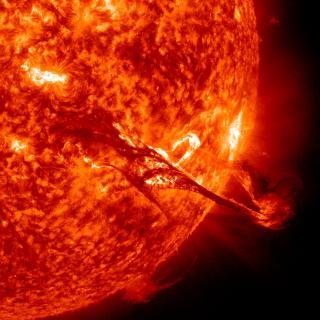Bibcode
Gómez Míguez, M. M.; Martínez Gómez, D.; Khomenko, E.; Vitas, N.
Bibliographical reference
Philosophical Transactions of the Royal Society of London Series A
Advertised on:
6
2024
Citations
1
Refereed citations
1
Description
Solar partially ionized plasma is frequently modelled using single-fluid (1F) or two-fluid (2F) approaches. In the 1F case, charge-neutral interactions are often described through ambipolar diffusion, while the 2F model fully considers charge-neutral drifts. Here, we expand the definition of the ambipolar diffusion coefficient to include inelastic collisions (ion/rec) in two cases: a VAL3C one-dimensional model and a 2F simulation of the Rayleigh-Taylor instability (RTI) in a solar prominence thread based on [Lukin et al. 2024 Phil. Trans. R. Soc. A 382, 20230417. (doi:10.1098/rsta.2023.0417)]. On one side, we evaluate the relative importance of the inelastic contribution, compared to elastic and charge-exchange collisions. On the other side, we compare the contributions of ion/rec, thermal pressure, viscosity and magnetic forces to the charge-neutral drift velocity of the turbulent flow of the RTI. Our analysis reveals that the contribution of inelastic collisions to the ambipolar diffusion coefficient is negligible across the chromosphere, allowing the classical definition of this coefficient to be safely used in 1F modelling. However, in the transition region, the contribution of inelastic collisions can become as significant as that of elastic collisions. Furthermore, we ascertain that the thermal pressure force predominantly influences the charge-neutral drifts in the RTI model, surpassing the impact of the magnetic force.
This article is part of the theme issue `Partially ionized plasma of the solar atmosphere: recent advances and future pathways'.
Related projects

Solar and Stellar Magnetism
Magnetic fields are at the base of star formation and stellar structure and evolution. When stars are born, magnetic fields brake the rotation during the collapse of the mollecular cloud. In the end of the life of a star, magnetic fields can play a key role in the form of the strong winds that lead to the last stages of stellar evolution. During
Tobías
Felipe García

Numerical Simulation of Astrophysical Processes
Numerical simulation through complex computer codes has been a fundamental tool in physics and technology research for decades. The rapid growth of computing capabilities, coupled with significant advances in numerical mathematics, has made this branch of research accessible to medium-sized research centers, bridging the gap between theoretical and
Daniel Elías
Nóbrega Siverio